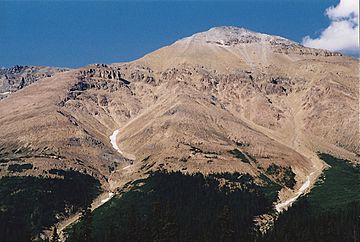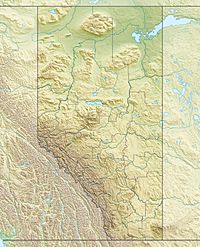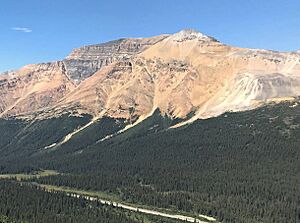Observation Peak (Alberta) facts for kids
Quick facts for kids Observation Peak |
|
|---|---|

Observation Peak, July 2003. Visible high point is the false summit.
|
|
| Highest point | |
| Elevation | 3,174 m (10,413 ft) |
| Prominence | 644 m (2,113 ft) |
| Listing | Mountains of Alberta |
| Geography | |
| Parent range | Canadian Rockies |
| Topo map | NTS 82N/09 Hector Lake |
| Geology | |
| Age of rock | Precambrian to Jurassic |
| Mountain type | sedimentary rock |
| Climbing | |
| First ascent | 1895 by Bill Peyto and Walter Wilcox |
| Easiest route | easy/moderate scramble |
Observation Peak is a tall mountain located in Banff National Park, Alberta, Canada. It stands at about 3,174 meters (10,413 feet) high. You can see this impressive peak from the Icefields Parkway, especially near the Bow Summit area.
The mountain got its name in 1898 from Charles L. Noyes. He was a clergyman from Boston who climbed the peak. He felt it offered the best view he had ever seen, so he named it "Observation Peak."
Climbing Observation Peak is often done by "scrambling" up its western slopes. Scrambling is like a mix of hiking and easy rock climbing. After reaching a spot called the "false summit," it's about a 20-minute walk to the true summit, which is about 100 meters (328 feet) higher.
Understanding Observation Peak's Rocks
Like many mountains in Banff Park, Observation Peak is made of sedimentary rock. This type of rock forms from layers of sand, mud, and tiny bits of ancient sea creatures. These layers were laid down over millions of years, from the Precambrian to the Jurassic periods.
Long ago, these rocks formed in shallow seas. Later, a huge event called the Laramide orogeny pushed these rock layers eastward. This movement caused the older sedimentary rock to slide over younger rock, creating the mountain shapes we see today.
Climate Around Observation Peak
Observation Peak is in a subarctic climate zone. This means it has very cold, snowy winters. Summers are usually mild, but still cool. Temperatures can often drop below -20 °C (-4 °F). With the wind, it can feel even colder, sometimes below -30 °C (-22 °F).
Snow and ice from Observation Peak melt and create water runoff. This water flows into the Mistaya River. The Mistaya River is a branch of the North Saskatchewan River, which eventually flows across Canada.



